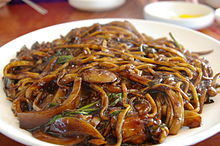- Jajangmyeon
-
Jajangmyeon 
Korean name Hangul 자장면/짜장면 Hanja 炸醬麵 Revised Romanization Jajangmyeon/Jjajangmyeon McCune–Reischauer Chajangmyŏn/Tchajangmyŏn Jajangmyeon (alternately spelled jjajangmyeon; 자장면; 짜장면) is a popular Korean dish, derived from the Chinese dish zha jiang mian. It consists of wheat noodles topped with a thick sauce made of chunjang (a salty black soybean paste), diced meat and vegetables, and sometimes also seafood. Jajang (alternately spelled jjajang), the name of the sauce, is the Korean pronunciation of the Chinese characters 炸醬, which literally means "fried sauce." Myeon (also spelled myun) means "noodle."
Contents
History
Jajangmyeon was first created in the city of Incheon, where early Chinese migrants to Korea began to settle in the late 19th century. The dish was arguably first developed in a Chinese restaurant called Gonghwachun (공화춘; 共和春 - meaning Republican Spring) in Incheon around 1905. The city of Incheon sponsored the "100 year anniversary of the birth of jajangmyeon" in 2005.[1]
The dish originated from zha jiang mian (炸醬麵, literally "fried sauce noodles") in China's Shandong region. The pronunciation of the dish's name is nearly identical to that of its Korean counterpart. But Korean jajangmyeon differs from Chinese zha jiang mian, as Korean zajangmyeon uses black Korean chunjang including caramel, and onions that Chinese zha jiang mian does not use. Korean-style jajangmyeon has also been gaining popularity in China recently.[1]
Popularity
With about 100 years of history, jajangmyeon is called one of the "national foods" of South Korea. It is a popular dish among families because of its taste and inexpensive cost to prepare. It has been, by far, the most popular delivery food in Korea, and almost every Chinese restaurant in Korea has jajangmyun on its menu. As of March 2009, six million servings of jajangmyun are sold in South Korea per day, and it was chosen as one of the top 100 "Korean cultural symbols" by the South Korean Government in 2006.[1]
Ingredients
Noodles
Jajangmyeon uses thick noodles made from white wheat flour. The noodles, which are made entirely by hand and not by machines, are called sutamyeon (수타면; 手打麵) are praised in South Korea as an essential ingredient of good jajangmyeon.
Sauce
The sauce is made with a dark soybean paste. This paste, which is made from roasted soybeans and caramel, is called chunjang (literally "spring paste", hangul: 춘장; Chinese: 春醬) when unheated, while the heated sauce (containing vegetables and meat or seafood) is called jjajang (literally "fried sauce"). Chunjang is stir-fried with diced onions, ground meat (either beef or pork) or chopped seafood, and other ingredients. The meat stock is added to reduce the salty taste, and potato starch or cornstarch is added to give the sauce a thick consistency. The sauce is served hot over noodles, sometimes with sliced raw cucumbers.
Accompaniments
Jajangmyeon is always served with a small amount of danmuji (단무지). The dish is often served with a small amount of sliced raw onions, seasoned with rice vinegar, accompanied with a little jajang sauce. The diner eats the noodle with danmuji and onions dipped in jajang sauce.
Variations
Variations of the jajangmyeon dish include ganjajangmyeon (간자장면), which is jajangmyeon served with the jajang sauce without the starch, with the sauce and noodles being served separately in different bowls, and samseon jajangmyeon (삼선자장면; 三鮮炸醬麵), which incorporates seafood such as squid, shrimp, sea cucumber, and others (but never fish). Samseon ganjajangmyeon (삼선간자장면; 三鮮간炸醬麵) consists of noodles served with sauce, which contains seafood on the side. Jajangbap is essentially the same dish as jajangmyeon, but made with rice instead of noodles.
Instant jajangmyeon is also popular in South Korea. Dried noodles are boiled in the same manner as instant ramen with dried vegetable bits, drained, and mixed with jajang powder and a small amount of water and oil.
Korean spelling and pronunciation controversy
The dish has been known in South Korea as jjajangmyeon (or chajangmyeon; 짜장면) since the first time the dish was imported to Korea. Even in current times, the vast majority of Korean Chinese restaurants use this Korean spelling.
However, Korean Alphabetization of Foreign Words (외래어 표기법; 外來語 標記法), a manual under a regulation issued by Korean Ministry of Culture and Education (문화교육부; 文化敎育部) (currently Ministry of Education, Science and Technology (교육과학기술부; 敎育科學技術部) in 1986, ruled that the Korean alphabetization of stop consonants (e.g. 짜; jja; Cha) should not use Korean fortis except for some established usages. According to this rule, the Korean alphabetization of the word '짜장면' is jajangmyeon. As a result, the alphabetization of the dish in recent years has been jajangmyeon in official government documents and the mainstream media.[2]
However, there have been noticeable criticisms on the Korean alphabetization of this word. Those in favor of the alphabetization jjajangmyeon question if champon should really be called Jambong as per the official manual (the popular dish was allowed to be alphabetized jjambbong as an exception to the rule). According to the 95th episode of Korean food culture cartoon Sikgaek (식객; 食客), Ahn Do Hyun (안도현), a Korean poet, announced that he would always write the dish's name as '짜장면,' not '자장면,' because the former is the name with which he associates all his childhood memories of the dish.
Also, in most old Korean dictionaries, the hanja for 'jajangmyeon' is "酢醬麵". The first hanja's Chinese pronunciation is similar to 'ja', and the hanja 炸's Chinese pronunciation is close to 'jja'.
On August 31, 2011, The National Institute of The Korean Language (국립국어원; 國立國語院) announced that jjajangmyeon (짜장면) has been accepted as an alternate standard spelling of the dish alongside the existing jajangmyeon (자장면) on August 22, 2011, and has been added to the Standard Korean Language Dictionary (표준국어대사전; 標準國語大辭典) with 38 other words, hoping to end the long-standing discrepancy between the commonly used spelling and the standard spelling.[3]
See also
- Korean cuisine
- List of Korea-related topics
- Korean Chinese cuisine
- Zhajiang mian
- Sweet bean sauce
References
Huh, Y. (2008). 식객 19 [Sikgaek 19]. Seoul, Korea: Kimyoungsa. ISBN : 9788934927860
Notes
External links
Categories:
Wikimedia Foundation. 2010.
